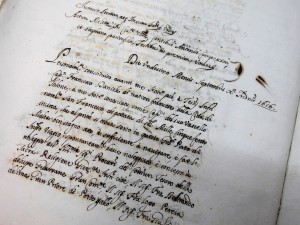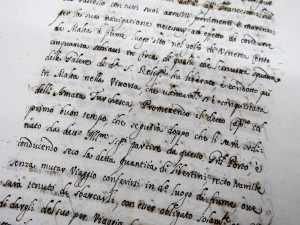-
A sea of profits
A search through historical notarial deeds reveals how Maltese businesses exploited the cruel reality of war and slavery, maritime historian Dr Joan Abela tells Fiona Vella.
 “Even though there are people who might think that the human tragedy which we are experiencing today in the Mediterranean Sea may be something contemporary, in reality, the human element has always been an issue in this region,” Dr Joan Abela says as she refers me to some thick manuscripts that she had set aside at the Notarial Archives in Valletta.
“Even though there are people who might think that the human tragedy which we are experiencing today in the Mediterranean Sea may be something contemporary, in reality, the human element has always been an issue in this region,” Dr Joan Abela says as she refers me to some thick manuscripts that she had set aside at the Notarial Archives in Valletta.We had agreed to discuss the dreadful reality of slavery in the old days and these manuscripts are witness to this phenomenon which took place even in our islands.
“Before the Knights of St John came to Malta in 1530, the Maltese Islands were already involved in the enslavement business and this was quite a legitimate affair at the time. People captured as slaves or captives were considered as commodities and their negotiations were regarded as valuable transactions, which when necessary, were also recorded in notarial deeds.”
Dr Abela continued to inform me that in that era, the traffic of slaves occupied a prime place in the economic activity of maritime trade in the southern Mediterranean since it allowed the profitable exchange of monies and commodities.
“Well aware of the strategic geographical location of Malta in the slave trade business, the Knights of St John established a strong infrastructure in order to attract more merchants and agents. Those who stopped at our islands would have been able to replenish their ships and to make use of the excellent and accomodating financial services which included the availability of notaries, agents, and money changers. Indeed, Braudel stated that Malta together with Livorno acted as a central hub for the slave trade.”
One needed to have a special license to work as a corsair, otherwise he would be regarded as a pirate and could be hanged for capturing ships, cargo or people illegally.
 “Since corsairing could render ample returns, people invested in it and received their respective shares from the bounty that the corsairs brought with them after they seized a ship. Investors consisted mainly of businessmen and knights. However, one would also find the Jerosolimitan Nuns of the Sovereign Military Hospitaller Order of St John which were located in St Ursula Street, Valletta, forming part of these investors. Their share was due to them for their role in praying for the safe return of the corsairs.”
“Since corsairing could render ample returns, people invested in it and received their respective shares from the bounty that the corsairs brought with them after they seized a ship. Investors consisted mainly of businessmen and knights. However, one would also find the Jerosolimitan Nuns of the Sovereign Military Hospitaller Order of St John which were located in St Ursula Street, Valletta, forming part of these investors. Their share was due to them for their role in praying for the safe return of the corsairs.”As Dr Abela began to indicate various episodes from the displayed manuscripts, she admitted that she was often very touched by what she read in those pages.
“Obviously when one looks at history in a collective manner, one would say that there was this particular circumstance taking place during that period and that is it. Yet when one looks into these documents and starts reading a deed about an individual life, one starts empathizing with that person and many questions will come to mind. For example, I came upon a deed wherein a priest was selling a slave together with her son to a Genovese merchant on condition that the latter would baptise the child on that same day. The merchant agreed and the deal was made. When you read something like this, how can you help not wonder who this woman was and from where she had come?”
Corsairing was a high risk job but if all went well, those involved could become rich overnight.
“Men craved for the opportunity to become corsairs and at one point, there were so many men leaving their jobs to join corsair ships that the Maltese Universitas requested the King of Spain to restrain this because the island was at a loss with the local workforce.”
“Not all the captured ships delivered the same profits. A galley of the Sultan which would have been filled with riches and fine cloth, would be precious but not without issues and trouble. Other ships would be carrying worthy cargo such as sugar or wheat. Nonetheless, it was the human cargo which was considered the most profitable.”
Captured people could be sold as slaves or held as captives until they were ransomed.
“The whole process for redemption was very complicated. These contracts unravel all this system including how the involved parties went about to assure the best positive outcome from their deal. An agent would be requested to act as an intermediary between one party and the other, taking responsibility to collect a deposit from the captive and then to take him to an agreed destination in order to collect the rest of the money from his relatives and then release him.”
“In April 1558, a slave, Busert Bin Hahmet de Casar concluded the following agreement with his master Giuseppe Baldagno. Busert was transferred to Antonio de Banda from Messina who was a patrone of a ship belonging to Marco Antonio Delixandro, also from Messina. The ship was equipped to undertake a voyage to the Tripolitan fortress of Barbaria. Antonio was to conduct the slave to Tripoli, and from there retrieve 80 gold ducats which was the stipulated price for redemption. This amount was to be remitted either in their value in dinars or in oil, wool or leather goods which the Arabs sold inside the Tripolitan fortress, which goods would be exempt from duty. Busert promised to pay Giuseppe within twenty days of his arrival at the fortress, on condition that the patrone was not to let him disembark unless he received the said payment or its value in goods. Once arrived at destination, the slave would need to make the necessary connection with an intermediary in his own country who would be in a position to acquire the redemption money or goods for him. Once the sum was settled, the slave would become a free man, but if the sum was not paid, he was to return with the same ship and consigned back to his master Giuseppe.”
 At times, the Grand Master had to issue a safe conduct certificate to enemy ships so that they might transfer the captives to the Tripoli port.
At times, the Grand Master had to issue a safe conduct certificate to enemy ships so that they might transfer the captives to the Tripoli port.“One such case was when Turgut Reis captured the ship Catharinet and took all her load to Djerba in 1548. Following this unfortunate capture for the Christian side, the Knight Augustino Spagno was sent as an envoy to negotiate redemption of the captives and once prices were fixed, a Muslim ship carrying these captives was to sail to the Order’s port in Tripoli.”
Interestingly, although being amid a Holy War against each other, this flourishing trade saw the collaboration and interaction between Christian and Muslim merchants.
“The capture of slaves did not only translate itself into financial rewards but acted also as a means to strengthen commercial ties between the various ethnic subjects of the cross and the crescent. Both Muslim and Christian merchants exploited this cruel reality and at times, this exploitation was so excessive that appeals were made to the local authorities to annul what plaintiffs described as usurious agreements which desperate souls had been forced to endorse in return for their freedom.”
“The Catholic Church strongly prohibited any compensation on loans, whether being related to business or not. Interest was regarded as usury and was not allowed. Often, this situation created shortages of cash money, especially after the Jewish community was expelled from the Maltese Islands in 1492. Nevertheless, there were numerous ways of circumventing this prohibition, such as through the difference quoted in the rate of exchange which would incorporate an agreed rate of interest or by paying the value in other goods.”
Besides ransom agents, there were also those agents who were summoned in order to make arrangements for the purchase of slaves to be delivered to Malta. Gender, age, ethnicity and price were agreed beforehand to eliminate any possible claims for additional payment.
“Although prices of slaves varied considerably, various studies indicate that the average selling price for a slave during the sixtenth century was in the region of 46 scudi. The acquisition of infidel slaves from Tripoli as a commodity for re-sale was one of the most profitable economic activities through which Malta registered a boom in her commerce.”
The arrival of Napoleon in 1798 abolished slavery in Malta and yet from litigation cases found in the Tribunal proceedings, during the early British Period, it is clear that the island’s association with slavery would not be terminated by a simple legislative enactment.
“And yet, back in the eighteenth century, people had already realized that the raiding system was over and that it was not feasible anymore. A new system based on lawful commerce and trade began to emerge; the Pinto stores being evidence of such change.”
(This article was published in the Family Business Supplement issued with The Times of Malta dated 24 February 2017)
Category: Times of Malta | Tags: 1492,1548,1798,Antonio de Banda,Braudel,British Period,Busert Bin Hahmet de Casar,captive,Catharinet,Catholic Church,corsair,Djerba,Dr Joan Abela,Giuseppe Baldagno,historical notarial deeds,Holy War,Jerosolimitan Nuns of the Sovereign Military Hospitaller Order of St John,Jews,King of Spain,Knight Augustino Spagno,Knights of St John,legal documents,Livorno,Malta,Maltese Universitas,Marco Antonio Delixandro,Mediterranean Sea,Messina,Muslim,Napoleon,Notarial Archives,Pinto,pirate,slave,slavery,St Ursula Street,traffic of slaves,Tripolitan fortress of Barbaria,Turgut Reis,Valletta